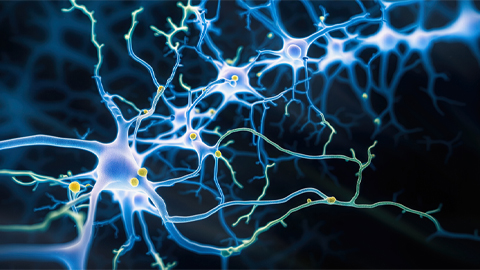Decoding microglial language
Microglia are resident immune cells of the central nervous system that can be rapidly activated to initiate immune responses. They play an important role in neurodegenerative diseases and neuroinflammation. Neurodegenerative disease-associated microglia, or DAM, mediate neuroinflammatory responses in Alzheimer’s disease by secreting extracellular vesicles. These EVs are lipid-bound vesicles composed of lipids, proteins, metabolites and nucleic acids. Researchers do not yet know how EVs modulate cell-to-cell communication in disease pathogenesis.
Scientists at Emory University used proteomics and transcriptomics to interpret the microglial language and to understand how EVs’ cargo transfers an inflammatory signal to recipient cells, thus exacerbating neuroinflammatory conditions. Their study was published in Molecular & Cellular Proteomics.

The first author, Juliet Santiago, recently graduated from Emory. “I like to compare intercellular communication to UPS or FedEx, where EVs are the packages sent from one cell to another,” she said. “EVs carry messages or signals contained within the package that can impact the recipient. In this case, initiating an inflammatory response in the recipient cell. Microglia-secreted EV cargo has the potential to elicit an inflammatory response and to transmit those signals to other microglia, worsening the inflammatory condition.”
Microglia alter their morphology, molecular profile and function in response to immune activators, exerting different functions in different diseases. Microglia-mediated neuroinflammation is a key pathological component of several neurodegenerative diseases, including Alzheimer’s. These extracellular vesicles released by microglia contribute to how Alzheimer’s propagates and progresses over time.
The microglial activation state determines EVs’ unique molecular profiles. In this study, the research team used size-exclusion chromatography to purify EVs from BV-2, a microglial cell line and obtained their molecular profiles with label-free quantitative mass spectrometry and mRNA and noncoding RNA sequencing methods.
The corresponding author of the paper Srikant Rangaraju, now a professor at Yale University, was a professor at Emory University when this work was published. “We use in vitro models to obtain microglia cells,” he said, “and exposed them to different stimuli to understand what protein and RNA changes are happening in the extracellular vesicles specifically.”
The researchers treated BV2 microglia with lipopolysaccharide, interleukin-10 or transforming growth factor beta, to mimic proinflammatory, anti-inflammatory or homeostatic states, respectively. Their proteomic and transcriptomic analysis showed that lipopolysaccharide treatment profoundly impacted the compositions of microglia-derived EVs. Further, they found that EVs derived from lipopolysaccharide-activated microglia were able to induce proinflammatory transcriptomic changes in resting responder microglia, confirming the ability of microglia-derived EVs to relay inflammatory signals.
“We found that the state of microglia impacts the profile of the extracellular vesicles they secrete,” Santiago said. “Taking it a step further, we did transcriptomics on the secreted EVs cargo and we were able to quantify the messenger RNAs. The EVs released after inflammation contained an abundant amount of messenger RNA making us realize that maybe these EVs were mediating translation in the recipient cell, deciding the fate of the recipient cell. In short, EVs have the potential to affect the course of disease progression.”
EVs also play a critical role in cancer progression and viral infections. Scientists are working to engineer EVs to deliver drugs because they can cross the blood-brain barrier.
“Engineering EV cargo for drug delivery or small molecule delivery directly at the affected regions like the brain to help bring about anti-inflammatory responses for rehabilitation or treatment would be a game changer,” Santiago said.
Enjoy reading ASBMB Today?
Become a member to receive the print edition four times a year and the digital edition monthly.
Learn moreGet the latest from ASBMB Today
Enter your email address, and we’ll send you a weekly email with recent articles, interviews and more.
Latest in Science
Science highlights or most popular articles

Bacteriophage protein could make queso fresco safer
Researchers characterized the structure and function of PlyP100, a bacteriophage protein that shows promise as a food-safe antimicrobial for preventing Listeria monocytogenes growth in fresh cheeses.

Building the blueprint to block HIV
Wesley Sundquist will present his work on the HIV capsid and revolutionary drug, Lenacapavir, at the ASBMB Annual Meeting, March 7–10, in Maryland.

Gut microbes hijack cancer pathway in high-fat diets
Researchers at the Feinstein Institutes for Medical Research found that a high-fat diet increases ammonia-producing bacteria in the gut microbiome of mice, which in turn disrupts TGF-β signaling and promotes colorectal cancer.

Mapping fentanyl’s cellular footprint
Using a new imaging method, researchers at State University of New York at Buffalo traced fentanyl’s effects inside brain immune cells, revealing how the drug alters lipid droplets, pointing to new paths for addiction diagnostics.

Designing life’s building blocks with AI
Tanja Kortemme, a professor at the University of California, San Francisco, will discuss her research using computational biology to engineer proteins at the 2026 ASBMB Annual Meeting.

Cholesterol as a novel biomarker for Fragile X syndrome
Researchers in Quebec identified lower levels of a brain cholesterol metabolite, 24-hydroxycholesterol, in patients with fragile X syndrome, a finding that could provide a simple blood-based biomarker for understanding and managing the condition.

